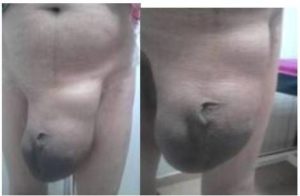Discussion
Giant inguinoscrotal hernias, which are rare condition in developed one, can be simply described as “a hernia that is extending further down the mid-point of the medial side of the thigh.” The patients can present with symptoms such as urinary retention and testicular pain as in our case, and testicular tumors, acute epididymitis, epididymal cyst, or rarely hematocele can be included in the differential diagnosis (Vano-Galvan 2009). Therefore, inguinoscrotal hernias, as well as urological pathologies, should be kept in mind in such cases.
The treatment is the main point to focus on for giant inguinoscrotal hernias, where extremely specific surgical techniques could be mentioned. Treatment decision should be made depending primarily on the urgency of the cases. In patients who need to be operated under the emergency indication, priority is given to the removal of necrotic tissues, rather than to the closure of the defect, whereas different techniques are used for elective operations by considering the status of patients (Vano-Galvan 2009) Before discussing these techniques, we find it useful to remind that such cases are the patients who are typically elderly and have comorbid diseases and high risk of postoperative complications (El Saadi 2005, Garavello 2004) . In Ezer et al.’s study conducted in 2011, a postoperative complication rate of 20% and a mortality rate of 3% were reported, which revealed a significant correlation between age and comorbid diseases and postoperative morbidity and mortality (Ezer 2011). Considering that the cases with giant inguinoscrotal hernia are the patients who are typically elderly and have comorbid diseases will provide better understanding of the importance of early diagnosis and early treatment in minimizing morbidity and mortality. We can better understand rationality of conducting preventive health policy instead of a therapeutic one. Also, it is obvious that the probability of operators, who work in the countryside, facing cases diagnosed at this stage will decrease if the necessary educational activities about the self-care of the patients are provided, and subsequently the accessibility of primary health care services is established and the optimal processing of diagnostic and referral systems is ensured in the countryside.
Extremely specific surgical techniques could be mentioned in the treatment of such an inguinoscrotal hernia diagnosed in the final phases, and even finding an intra-abdominal area for the reduction of a hernia of such a large volume emerges as a problem in itself (Coetzee 2011). Forced reduction into the intra-abdominal cavity can be provided with simple herniorrhaphy technique (Tahir 2008), as well as techniques such as creating space by pneumoperitoneum-flap-patch methods (Tahir 2008, Valliattu 2008) or emptying an area by organ resections (Vasiliadis 2010, Patsas 2010) can be applied. Giant scrotal hernia cases with specific morbidities such as renal failure due to intravesical obstruction, intestinal malrotation, or different surgical approaches have been published in the literature(Savoie 2013) .Our case is the third patient reported by the authors of this paper from the region within a short time. In addition, these cases are just demonstrative examples of a small sample group encountered in the general surgery outpatient clinic of the relevant center. We believe that sharing such examples primarily in the literature at least in terms of enriching the notion of an international emergency surgery will be a driving force in establishing more effective health policies by increasing the awareness among physicians especially young physicians and residents who are supposed to be studying in many different regions of the different countries.
References
Chernev, I. (2010). “A Giant Inguinoscrotal Hernia,” The Scientific World Journal 2010(10):72-3.
Publisher – Google Scholar
Coetzee, E., Price, C. & Boutall, A. (2011). “Simple Repair of a Giant Inguinoscrotal Hernia,” International Journal of Surgery Case Reports 2011; 2(3):32-5.
Publisher – Google Scholar
El Saadi, A. S., Al Wadan, A. H. & Hamerna, S. (2005). “Approach to a Giant Inguinoscrotal Hernia,” Hernia 2005(9); 3; 277-9.
Publisher – Google Scholar
Ezer, A., Çalışkan, K., Çolakoğlu, T., et al. (2011). “Factors Affecting Morbidity in Urgent Repair of Abdominal Wall Hernia with Intestinal Incarceration in Adults,” Ulusal Travma ve Acil Cerrahi Dergisi 2011; 17(4):344-48.
Publisher – Google Scholar
Garavello, A., Manfroni, S. & Antonellis, D. (2004). “Inguinal Hernia in the Elderly. Indications,Techniques, Results,”Minerva Chirurgica. 2004Jun; 59(3):271-6.
Publisher – Google Scholar
Patsas, A., Tsiaousis, P., Papaziogas, B., et al. (2010). “Repair of a Giant Inguinoscrotal Hernia,” Hernia 2010; 14(3):305-7.
Publisher – Google Scholar
Savoie, P. H., Abdalla, S., Bordes, J., et al. (2013). “Surgical Repair of Giant Inguinoscrotal Hernias in an Austere Environment: Leaving the Distal Sac Limits Early Complications,” Hernia.2013 Mar 9. [Epub ahead of print].
Publisher – Google Scholar
Tahir, M., Ahmed, F. U. & Seenu, V. (2008). “Giant Inguinoscrotal Hernia:Case Report and Management Principles,”International Journal of Surgery 2008; 6(6):495-7.
Publisher – Google Scholar
Valliattu, A. J. & Kingsnorth, A. N. (2008). “Single-Stage Repair of Giant Inguinoscrotal Hernias Using the Abdominal Wall Component Seperation Technique,” Hernia 2008; 12(3):329-30.
Publisher – Google Scholar
Vano-Galvan, S., Guisado-Vasco, P. & Jaen, P. (2009). “Giant Inguinoscrotal Hernia,” Australian Family Physician 2009; 38(4):222-3.
Publisher – Google Scholar
Vasiliadis, K., Knaebel, H. P., Djakovic, N., et al. (2010). “Challenging Surgical Management of a Giant Inguinoscrotal Hernia: Report of a Case,” Surgery Today 2010; 40(7):684-7.
Publisher – Google Scholar




